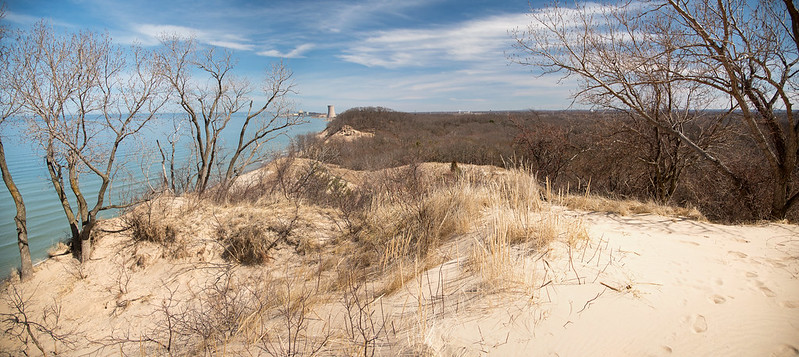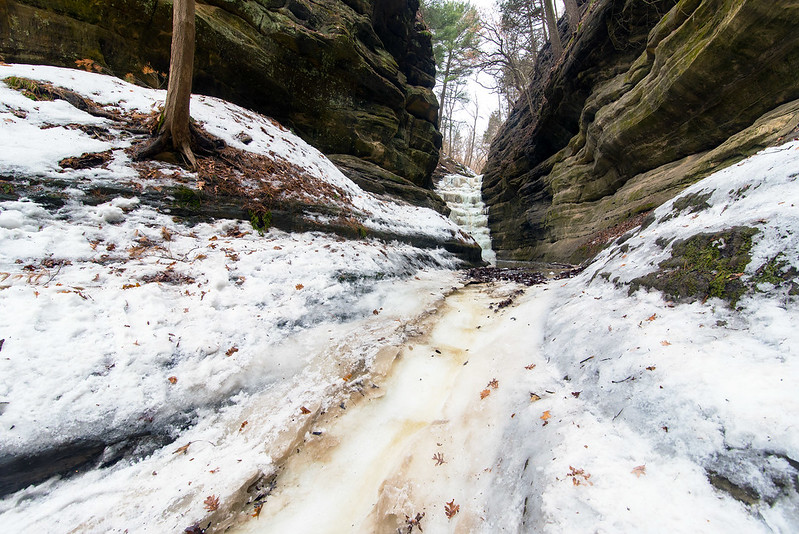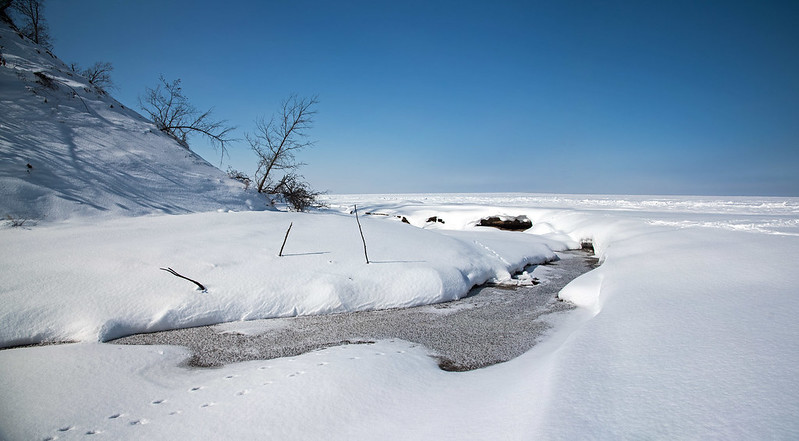
The Great Marsh

Developing Storms
 While kayaking at sunset, we watched two storms develop in the distance. The first was to the south, and the whispy clouds caught our attention at first. They soon developed into billowing clouds highlighted by the setting sun. After the sun sank below the horizon, the lake and trees darkened, but the storm clouds remained vibrant for quite some time. Lightning could be seen between the clouds, but the storm never came any closer to us.
This image was made with four individual photos stitched together side by side. I only had a 100mm lens with me, so a panoramic image was necessary to capture the entire cloud.
While kayaking at sunset, we watched two storms develop in the distance. The first was to the south, and the whispy clouds caught our attention at first. They soon developed into billowing clouds highlighted by the setting sun. After the sun sank below the horizon, the lake and trees darkened, but the storm clouds remained vibrant for quite some time. Lightning could be seen between the clouds, but the storm never came any closer to us.
This image was made with four individual photos stitched together side by side. I only had a 100mm lens with me, so a panoramic image was necessary to capture the entire cloud.
 At the very same time, to the east was an even larger storm developing. Again it was highlighted by the setting sun and never approached us, we remained dry the entire weekend. This panoramic image was created with eight separate images taken with a 100mm lens while sitting in a kayak on the lake.
Paddling any time during the day is great, but paddling at sunset and after dark is especially interesting. Our 11pm trips are always inspiring.
At the very same time, to the east was an even larger storm developing. Again it was highlighted by the setting sun and never approached us, we remained dry the entire weekend. This panoramic image was created with eight separate images taken with a 100mm lens while sitting in a kayak on the lake.
Paddling any time during the day is great, but paddling at sunset and after dark is especially interesting. Our 11pm trips are always inspiring.
Superior Mirage

Fiddleheads


The Waxing Crescent

Colorful Lake Michigan
 Certain mornings play with Lake Michigan's colors, and this was certainly one of those mornings. As we approached the end of the trail, which was once a road leading to homes and a beach access, we stood at the edge of the dune that overlooked the beach below. The dune is around 100 feet tall here, but with no people on the beach for reference, it looks as if I am standing on the beach itself.
The clouds cast shadows on the water, changing the color of the waters, and in addition, the sand is kicked up and circulated in the water, creating some deeper brown colors along the shore. While this coloration is not really unusual, it changes from moment to moment and often can't be seen from the beach itself.
Certain mornings play with Lake Michigan's colors, and this was certainly one of those mornings. As we approached the end of the trail, which was once a road leading to homes and a beach access, we stood at the edge of the dune that overlooked the beach below. The dune is around 100 feet tall here, but with no people on the beach for reference, it looks as if I am standing on the beach itself.
The clouds cast shadows on the water, changing the color of the waters, and in addition, the sand is kicked up and circulated in the water, creating some deeper brown colors along the shore. While this coloration is not really unusual, it changes from moment to moment and often can't be seen from the beach itself.
 Following what was once California Avenue, we found the end of the road - which led right off the dune to the beach below. I remember walking this road and Valley Drive when there were still homes on them. And often, after the homes were razed, we would follow a path along the top of the dunes right at the lakefront. This path has since been washed into Lake Michigan - but not because people walked on it as the park service would seem to want you to believe. People do much less damage to the dunes when they follow a path or trail than they do if you block off the traditonal paths. Some will simply walk around the sign or barricade, creating more damage as they walk around. Lake Michigan eroded the dunes here, not people walking on the dunes.
Following what was once California Avenue, we found the end of the road - which led right off the dune to the beach below. I remember walking this road and Valley Drive when there were still homes on them. And often, after the homes were razed, we would follow a path along the top of the dunes right at the lakefront. This path has since been washed into Lake Michigan - but not because people walked on it as the park service would seem to want you to believe. People do much less damage to the dunes when they follow a path or trail than they do if you block off the traditonal paths. Some will simply walk around the sign or barricade, creating more damage as they walk around. Lake Michigan eroded the dunes here, not people walking on the dunes.
Last Sunset of Winter

The Dormant Dunes

Morning on Top of the Dune

The Thawing Ice Falls

Approaching the Dual Waterfalls

Lake Falls

Not only is the ice melting, but to get to the frozen waterfalls is much more difficult if you wish to stay warm and dry. The paths for at least two of these falls were under at least a foot of flowing water. We decided to visit them anyway, and walked through the cold water; our feet were cold for about 10 minutes as the 35 degree water flooded our boots. But after that, they remained a rather comfortable temperature as our body heat warmed up the water in our boots. Even if our feet stayed cold, it was worth the effort to see these falls once again.
Frozen French Canyon

These waterfalls tend to stay frozen for a bit longer than the fragile falls in LaSalle Canyon because they're thicker and in more shaded canyons. French Canyon is one of those very shady locations and generally doesn't have a huge amount of water flowing into the canyon. A heavy flow of water quickly melts the ice formations, while a more gentle one cascades over, under, or around the ice.
This canyon is generally a bit tricky to access when the stream is flowing (if you don't want wet feet), but in winter, it's extremely slippery and difficult to access. Park staff at the visitor's center have told us time and time again that it's not worth even trying to get into French Canyon in the winter - it's too dangerous. The stream flows directly on the portion of the canyon floor that is used for walking, so plenty of ice forms in this area. Without ice cleats on your boots, it's next to impossible to safely walk up into this canyon. Because we've been here many times before, we had our cleats with us.
Every day the warm weather eats away at the ice in all 18 canyons of Starved Rock, so if you hope to see some frozen waterfalls, it's best to visit very soon, or you will need to wait until next winter. Bring ice cleats even if you think the trails are clear - you will need them - sometimes into April.
The Thawing Shelf Ice

The Snow Covered Trail

Following our walk along the beach, we headed up to an old trail that led to the top of one of the dunes near Kintzele Ditch. An old road leads to the trail, and while the walk is generally easy, our trip this time was a bit more difficult due to the knee-deep snow we needed to move through. Not terribly bad on the flat areas, but up the dune was more strenuous, especially near the top where the snow piled up in tall drifts.

We couldn't imagine not working our way through the snow when we came so far already. Putting out quite a bit of effort in the sunny, 15 degree Fahrenheit weather actually made us sweat. Jackets open, hats and gloves off and we were ready to take on the snowy dune for what I imagined would be a great, winter view of Lake Michigan. We were not disappointed.
Still, even if we didn't make it to the top, just being in the woods after a heavy snowfall was good enough for us.
Hidden Creek

Frozen Kintzele Ditch From the Ground
The heavy snowfall covered the beach and much of the ice covered Kintzele Ditch as it winds through the sand and empties in to Lake Michigan. The view from above couldn't show the depth of the snow and the snow drifts, but the view from the sand shows the snow a bit better.
The creek cuts through the sand and creates a three foot deep cut in the sand, the snow drifted over the ice and cuts, hiding the deeper areas. If one would keep walking, they most likely would end up in snow above their waist! This particular area changes daily sometimes - especially in summer where the waves move the sand and change the direction of the creek. The ice and snow in winter protect the shore from these changes, so for now, Kintzele Ditch will maintain its current flow to Lake Michigan.
Heavy Snowfall on the Lakefront

Our hike began about 1/2 mile away, and once down the slippery dune to the beach, we realized just how much snow actually fell over the past couple of weeks. On average, the snow was past our knees as we made our way toward Kintzele Ditch, in a few places it was shallower, but in others, well past our knees. With all the snow, it was difficult to see exactly where the shore was, so we were careful not to walk out onto the shelf ice. Knowing the area very well, we could estimate and stay safe.
When we reached Kintzele Ditch, it too was iced over and covered in snow. The path of the creek can change daily, so we needed to walk where we knew solid ground was beneath us. If you look closely, you will see our footprints in the snow, walking up to the creek then turning toward the dune. We were able to get to the trail up the dune a bit later. It's an old road that has been abandoned for years, and the snow here was even deeper in spots - up to our pants pockets. That made the walk up pretty difficult and slow, and we questioned if we should try to walk up, but once at the top, we were treated to the scene pictured above. Ice and snow as far as the eye can see on frozen Lake Michigan, and drifted snow all across the dunes and beach. The image is a panoramic image made from three images stitched together.
Kaskaskia Canyon Icefalls
T This waterfall isn't very tall, but the two logs that were washed down the canyon during some past flood add a lot of interest to the image. Behind the fall is a cave that we usually don't venture into because of the story I heard from a friend who fell through the ice here into the water below that was up past his waist. On this visit, we noticed several other people walking around that area, and with the two weeks of very cold temperatures, we knew the ice was thick enough to support us.

While typically not a canyon for ice climbing, I have seen a few people climbing this icefall in the past, and this year, a family with climbing gear and helmets were approaching was we were leaving. I would think this is a good fall to climb for beginners, and also for experienced climbers who don't have the ability to fasten lines to the trees above. This fall would be challenging enough, and if you did slip, you wouldn't fall 80 feet to the canyon floor.
On To Icy Ottawa Canyon



















